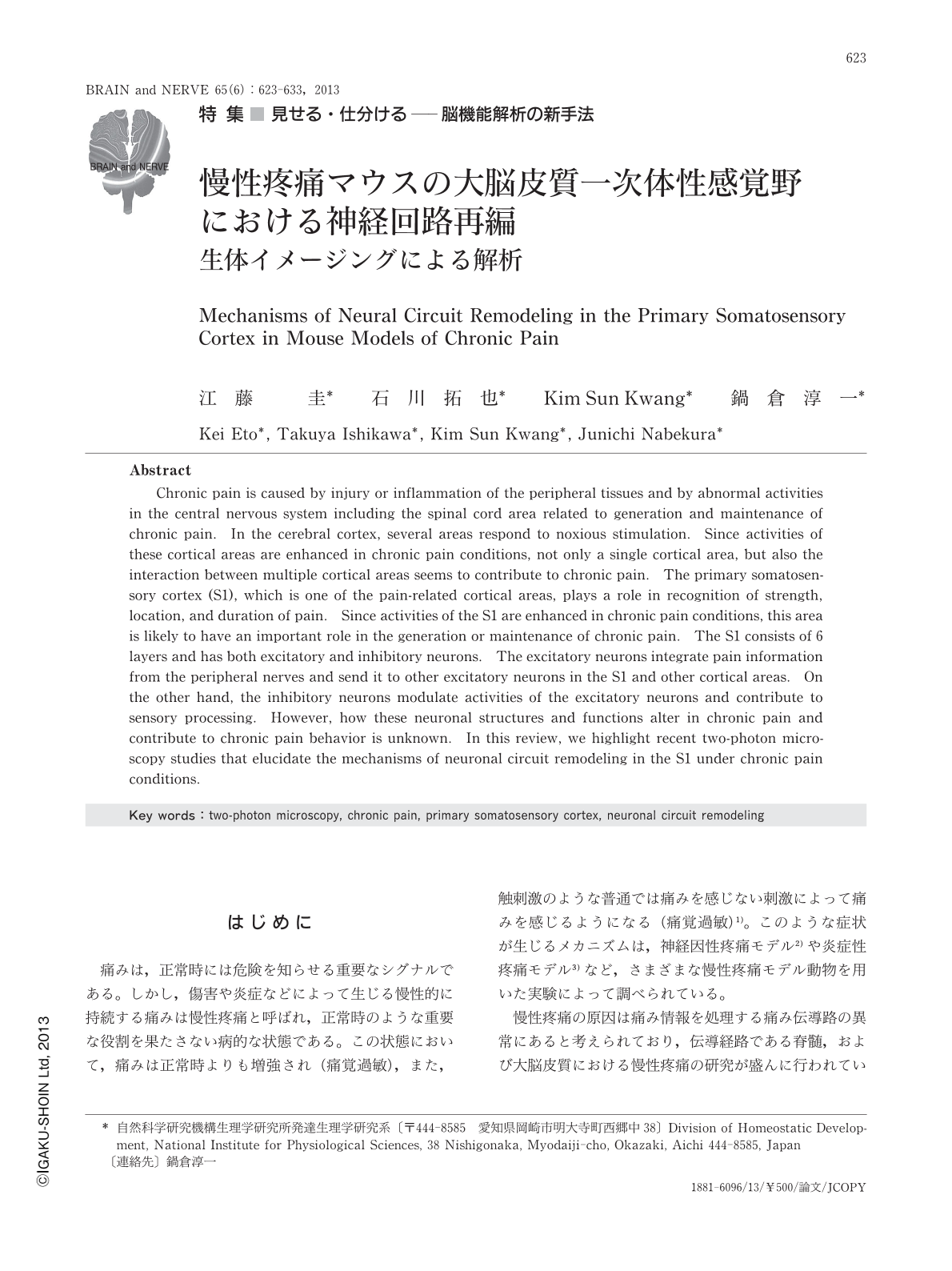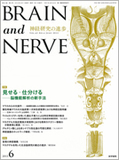Japanese
English
- 有料閲覧
- Abstract 文献概要
- 1ページ目 Look Inside
- 参考文献 Reference
はじめに
痛みは,正常時には危険を知らせる重要なシグナルである。しかし,傷害や炎症などによって生じる慢性的に持続する痛みは慢性疼痛と呼ばれ,正常時のような重要な役割を果たさない病的な状態である。この状態において,痛みは正常時よりも増強され(痛覚過敏),また,触刺激のような普通では痛みを感じない刺激によって痛みを感じるようになる(痛覚過敏)1)。このような症状が生じるメカニズムは,神経因性疼痛モデル2)や炎症性疼痛モデル3)など,さまざまな慢性疼痛モデル動物を用いた実験によって調べられている。
慢性疼痛の原因は痛み情報を処理する痛み伝導路の異常にあると考えられており,伝導経路である脊髄,および大脳皮質における慢性疼痛の研究が盛んに行われている4)。脊髄に関する研究により,慢性疼痛時に脊髄後角神経細胞の過剰な活動亢進5)やグリア細胞の活性化6),抑制性神経伝達異常など7),さまざまな異常が起きることが明らかにされた。
一方,痛み情報の最終的な処理領域である大脳皮質においては,ヒトや慢性疼痛モデル動物でPET(positron emission tomography)や機能的核磁気共鳴画像(functional magnetic resonance imaging:fMRI)などのイメージング技術を用いた研究が行われ,一次体性感覚野(primary somatosensory cortex:S1)や前帯状回(anterior cingulate cortex:ACC)などの正常時に侵害刺激によって活性化される複数の脳領域の活動が慢性疼痛時には亢進することが明らかにされた8,9)。さらに,活動だけでなく,皮質構造も変化することから10,11),単一の脳領域のみならず,複数の脳領域間の相互作用も慢性疼痛処理に関与する可能性が示唆されている。痛み関連領域の1つであるS1は正常時においては痛みの強度と部位を認識するために重要であり12),慢性疼痛時においても痛みの認知に重要な役割を果たしている8)。しかし,fMRIやPETを用いたこれまでの実験では,脳全体の活動を計測することは可能だが,時間分解能や空間分解能の問題により,個々の領域を構成する細胞群のシナプス形態や細胞活動についてはわからなかった。
近年,開発された二光子レーザー顕微鏡は,fMRIやPETの時空間分解能の欠点を補うレーザー顕微鏡であり13),微細構造である神経シナプス構造の可視化ができるのみならず,in vivoカルシウムイメージング法を用いることで,生きた動物の脳を構成する神経細胞とアストロサイトの活動を単一細胞レベルの解像度で,かつfMRIやPETよりも高い時間分解能で観察することが可能となった14)。
そこで,本稿ではこの二光子レーザー顕微鏡を用いたシナプス構造観察,in vivoカルシウムイメージングを用いて得られた慢性疼痛時のS1に関する知見について紹介する。
Abstract
Chronic pain is caused by injury or inflammation of the peripheral tissues and by abnormal activities in the central nervous system including the spinal cord area related to generation and maintenance of chronic pain. In the cerebral cortex, several areas respond to noxious stimulation. Since activities of these cortical areas are enhanced in chronic pain conditions, not only a single cortical area, but also the interaction between multiple cortical areas seems to contribute to chronic pain. The primary somatosensory cortex (S1), which is one of the pain-related cortical areas, plays a role in recognition of strength, location, and duration of pain. Since activities of the S1 are enhanced in chronic pain conditions, this area is likely to have an important role in the generation or maintenance of chronic pain. The S1 consists of 6 layers and has both excitatory and inhibitory neurons. The excitatory neurons integrate pain information from the peripheral nerves and send it to other excitatory neurons in the S1 and other cortical areas. On the other hand, the inhibitory neurons modulate activities of the excitatory neurons and contribute to sensory processing. However, how these neuronal structures and functions alter in chronic pain and contribute to chronic pain behavior is unknown. In this review, we highlight recent two-photon microscopy studies that elucidate the mechanisms of neuronal circuit remodeling in the S1 under chronic pain conditions.

Copyright © 2013, Igaku-Shoin Ltd. All rights reserved.


